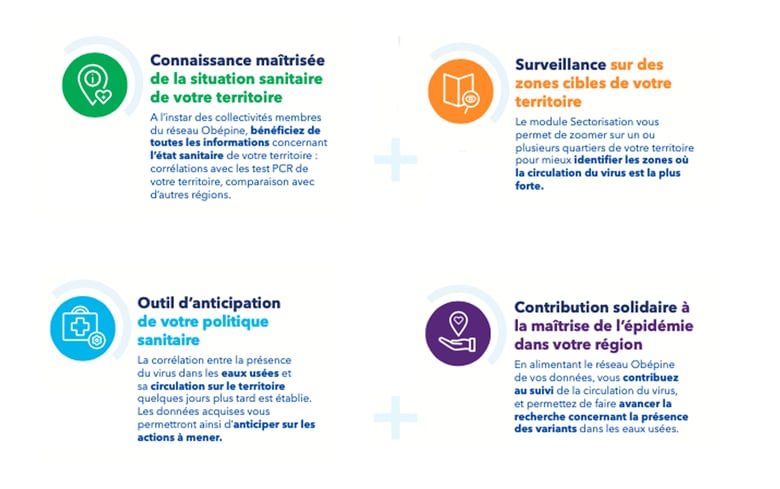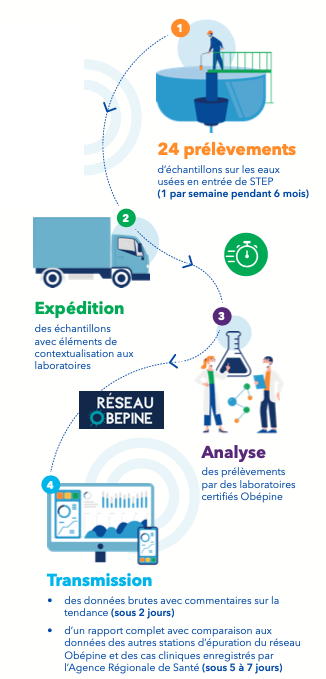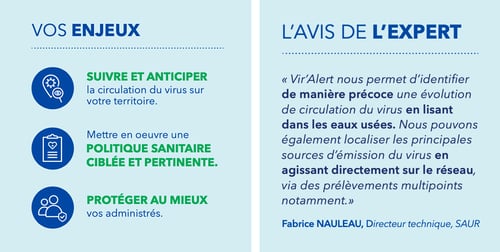The introduction of the epidemiological observatory for wastewater (the Obépine network) has enabled some local authorities to benefit from regular research work on the presence of SARS-CoV-2 at the inflow feed to their wastewater treatment plants. Others have not been so fortunate. However, they can now access the Vir'Alert solution launched by Saur Group in response to the urgent need to protect local populations. This solution offers them the same guarantee of being able to monitor the dynamic circulation of the coronavirus responsible for the Covid-19 pandemic through their wastewater drainage and treatment networks.
At the very beginning of the Covid-19 pandemic, laboratories and wastewater treatment plant operators came together to create an epidemiological observatory for wastewater: the Obépine network. The French government allocated €3.5 million to the program, effectively limiting to just 150 the number of local authorities that could, via their wastewater treatment plants, join the program and benefit from regular monitoring to detect the presence of SARS-CoV-2 in their wastewater. The 150 local authorities were selected on the basis of their geographic location and immediate environment.

To meet the needs of all the remaining local authorities that were also keen to monitor the circulation of coronavirus within their own areas, the experts at Saur devised a solution called Vir'Alert. It is based on the same type of contextualized average daily sampling of inflows to the treatment plant as those carried out for the fifty or so treatment plants operated by the Group as part of the Obépine network.
Targeting the origins of coronavirus in wastewater

Local authorities adopting the Vir'Alert solution can also benefit more comprehensively from the expertise of Saur Group as a wastewater network operator. Because when the numbers start to rise, it may well be time to extend sampling to include the wastewater drainage network to identify those branches which contribute the highest levels of coronavirus contaminated wastewater. Sampling - preferably daily rather than at longer intervals - of the branches of the system that connect to at-risk sources (schools, hospitals, nursing homes, etc.) will enable more effective targeting of any measures to be implemented in conjunction with the health authorities.
The Vir'Alert solution also includes a module designed specifically to reassure the local community and its residents by monitoring treated wastewater (again on the basis of average daily samples), residual sludge and even those watercourses accepting wastewater treatment plant discharges, including reused water, natural waters used for shellfish farming and/or bathing (on the basis of non-regular sampling). This is an effective way of ensuring that there is no trace of SARS-CoV-2 in all waters potentially contaminated by wastewater, wherever in the local authority area they may be.
Contributing to the national effort

The Vir'Alert solution offers local authorities the opportunity to make their contribution to the national effort to understanding and monitoring the Covid-19 pandemic. And to do so right from the very beginning! In reality, the results of all the analyses conducted at wastewater treatment plant inflow points are added to, and complement, the data collected by the network in full compliance with the Obépine protocol (naturally).
Ultimately, this data input improves the relevance of national statistics and informs interpretation of the results.
Researchers are now also working on a method for discriminating between SARS-CoV-2 variants. However, this work was not budgeted for at the time the network was launched, because the issue had simply not arisen.
Nevertheless, local authorities are now funding research on variants by paying a higher price for analyses. They will then benefit when the analytical system has been further developed to include variants.
For more information: